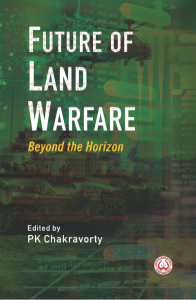
“Nothing remains static in war or military weapons, and it is consequently often dangerous to rely on courses suggested by apparent similarities in the past.” – Admiral Ernest Joseph King1
Future of Land Warfare: Beyond the Horizon is a book that serves as a testament to the perpetual endurance of the aforementioned quote by Adm. E.J. King. This book co-authored and edited by Maj. Gen. (Dr.) P.K. Chakravorty, VSM (Retd.), expertly meanders through the intricate complexities of elucidating upon an issue such as the future of warfare on the Indian subcontinent. The author has had an illustrious career having served as the Deputy Director-General of the Perspective Planning Directorate and as the Defence Attache to Vietnam. He is currently a Senior Fellow (Veteran) at the Centre for Land Warfare Studies (CLAWS). It is evident that one would find it difficult to obtain someone more adept for commenting on this sensitive subject. ‘Future of Warfare’ is an edited book which utilises the expertise of multiple authors to highlight the importance of futuristic planning within the Indian armed forces.
The book functions as an advisory to the Indian security establishment on the current scenario, the threats faced and the anticipated evolution of these threats in the future with respect to the Indian subcontinent. The book sets a timeframe up until 2035 so as to restrict the definition of the future to the forthcoming 15 years and therefore allow a more restricted and realistic assessment. It reiterates the current capabilities of the Indian armed forces and also delineates the course for augmentations and further advancements in Indian war-making capacity.
The book commences by providing a historical overview of the concept of land or ‘Janapada’ and its historical importance in the context of warfare and the notion of India from a strategic perspective. The book then proceeds to answer important strategic questions such as how and between whom shall future conflicts be fought and which particular incidents or triggers could lead to the breakout of war vis-a-vis India and its neighbours as also its internal threats among others. The book pays repeated and substantial emphasis on the need to transform the Indian armed forces into a modern warfighting force with less emphasis on manpower and more on the use of advanced technology. In that context, the book also discusses in significant detail land warfare in times of emerging technologies. In this regard, it details how India needs to indigenise its defence industry so as to be able to securely and thoroughly rely on its own capabilities rather than having to operate foreign technologies as in the present circumstances.
In an age of rapid information dissemination through multiple channels, the reverberations of information warfare are often psychologically injurious and contain the potential to leave deep scars in the long term. The book suggests that Information Warfare can be employed as a battle tactic in conjunction with conventional methods to cause psychological harm to the enemy, therefore demoralising their troops thereby ‘winning half the battle’. The editor’s own article stresses on modifications to the tactics employed by the conventional forces of India to conduct ‘manoeuvre warfare’ in which evolved technology is employed to decimate the firepower of the enemy before it can realise the extent of the attack. The book also discusses other aspects of future conflicts like the employment of special forces and aerial assets in the conduct of warfare. It describes the need to develop dedicated special forces capabilities in order to have the capability to conduct unconventional warfare, initial attempts towards which have been made in the past.
Especially engrossing is a chapter which assesses the theatre command structure of the People’s Liberation Army and its repercussions for India. This chapter analyses the PLA’s reorganisation along the lines of the Goldwater-Nichols Act of 1986 enforced by the United States to reorganise its armed forces to better serve its needs for contemporary and future warfare³. The insight provided by the author of this article into the reorganisation of the PLA and its current modus operandi is invaluable to the strategic community of India. Lastly, the book reaffirms the need to reorganise the Indian armed forces for future war scenarios and also stresses on the importance of logistics of warfare on a future battlefield.
India faces multiple adversaries within its neighbourhood. The increase in the threat perception post the Galwan Valley clash has necessitated a rethink in strategies and tactics employed previously. The political establishment of India must realise the need for indigenisation and modernisation of the armed forces so as to be able to successfully counter a two-pronged threat and safeguard the nation’s territorial integrity. The inception of the post of Chief of Defence Staff and the adoption of a tougher stance against aggression by the adversary are steps that have been welcomed but must now be followed up with long-standing institutional changes.
Future of Land Warfare: Beyond the Horizon is a must-read book for anyone with an association or affiliation to the geopolitical and strategic communities of India. This book dispenses to the reader an accurate knowledge of the various scenarios of warfare on the Indian subcontinent. The book prescribes important recommendations and urges the Indian armed forces to develop better response mechanisms so as to deliver swiftly and surely its firepower on the enemy all the while employing emerging methods and technologies in the area of warfighting. The authors display a high level of comprehension of the operational capabilities of our adversaries, thereby exhibiting the analytical faculties of our nation. The need for an overhaul is acute and pressing and this overhaul must occur across the entire spectrum of the Indian armed forces. In the words of Rosa Luxemburg – “those who do not move, do not notice their chains⁴.”
References
- King, Ernest Joseph, and Walter Muir Whitehill. Fleet Admiral King: A Naval Record. Taylor & Francis, 1976.
- Kenden, How media and vested interest group destroyed our Army’s perfectly working, very effective Covert Intel Unit: Part-1, MyVoice, 2020
- Saunders, Phillip C. and Wuthnow Joel. China’s Goldwater-Nichols? Assessing PLA Organisational Reforms, National Defense University Publications, Joint Force Quarterly 82 (2016), https://ndupress.ndu.edu/Media/News/Article/793267/chinas-goldwater-nichols-assessing-pla-organizational-reforms/ accessed on June 30, 2020.
- Luxemburg Rosa. The Acheron in Motion (Die Rote Fahne): Rosa Luxemburg’s Selected Political Writings. 1918.
Manan Aggarwal: He is graduate in International Relations Major from Symbiosis School for Liberal Arts. He is presently intern with CLAWS.














